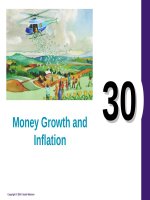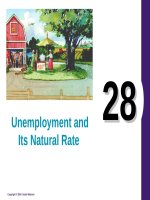Lecture Element of economics - Chapter 8: Market structures
Bạn đang xem bản rút gọn của tài liệu. Xem và tải ngay bản đầy đủ của tài liệu tại đây (960.59 KB, 76 trang )
Market
Structures
The Degree of Competition
• Classifying markets
– number of firms
– freedom of entry to industry
– nature of product
– nature of demand curve
• The four market structures
– perfect competition
– monopoly
– monopolistic competition
– oligopoly
Features of the four market structures
Features of the four market structures
Features of the four market structures
Features of the four market structures
Features of the four market structures
Features of the four market structures
The Degree of Competition
• Classifying markets
– number of firms
– freedom of entry to industry
– nature of product
– nature of demand curve
• The four market structures
– perfect competition
– monopoly
– monopolistic competition
– oligopoly
• Structure
conduct
performance
Perfect Competition
• Assumptions
– firms are price takers
– freedom of entry
– identical products
– perfect knowledge
• Short-run equilibrium of the firm
– price, output and profit
Short-run equilibrium of industry and firm under
perfect competition
P
£
MC
S
D = AR
= MR
AR
AC
Pe
D
O
O
Q (millions)
(a) Industry
AC
Qe
Q (thousands)
(b) Firm
Loss minimising under perfect competition
P
£
S
AC
P1
AC
MC
D1 = AR1
AR1
= MR1
D
O
O
Q (millions)
(a) Industry
Qe
Q (thousands)
(b) Firm
Perfect Competition
• Assumptions
– firms are price takers
– freedom of entry
– identical products
– perfect knowledge
• Short-run equilibrium of the firm
– price, output and profit
• The short-run supply curve of the firm
Perfect Competition
• Long-run equilibrium of the firm
– all supernormal profits competed away
– LRAC = AC = MC = MR = AR
Long-run equilibrium under perfect competition
New firms enter
P
Profits return
Supernormal profits
to normal
£
S1
Se
LRAC
P1
AR1
D1
PL
ARL
DL
D
O
O
Q (millions)
(a) Industry
QL
Q (thousands)
(b) Firm
Long-run equilibrium of the firm under perfect competition
£
(SR)MC
(SR)AC
LRAC
DL
AR = MR
LRAC = (SR)AC = (SR)MC = MR = AR
O
Q
Perfect Competition
• Incompatibility of economies of scale
with perfect competition
• Benefits of perfect competition
– price equals marginal cost
– prices kept low
– firms must be efficient to survive
Monopoly
• Defining monopoly
• Barriers to entry
– economies of scale
– economies of scope
– product differentiation and brand loyalty
– lower costs for an established firm
– ownership/control of key factors
– ownership/control over outlets
– legal protection
– mergers and takeovers
– aggressive tactics
– intimidation
Monopoly
• The monopolist’s demand curve
– downward sloping
– MR below AR
• Equilibrium price and output
– Equilibrium output, where MC = MR
Profit maximising under monopoly
£
MC
MR
O
Qm
Q
Monopoly
• The monopolist’s demand curve
– downward sloping
– MR below AR
• Equilibrium price and output
– Equilibrium output, where MC = MR
– Equilibrium price, found from demand curve
Profit maximising under monopoly
£
MC
AC
AR
AC
AR
MR
O
Qm
Q
Monopoly
• The monopolist’s demand curve
– downward sloping
– MR below AR
• Equilibrium price and output
– Equilibrium output, where MC = MR
– Equilibrium price, found from demand curve
• Profit
– Measuring profit
Profit maximising under monopoly
£
MC
Total profit
AC
AR
AC
AR
MR
O
Qm
Q
Monopoly
• The monopolist’s demand curve
– downward sloping
– MR below AR
• Equilibrium price and output
– Equilibrium output, where MC = MR
– Equilibrium price, found from demand curve
• Profit
– Measuring profit
– Supernormal profit can persist in long run









